New Centrality
Master of Architecture Design Studio, 2014
STUDIO LEADERS: Ferran Sagarra, Ian Nazareth
Sunshine is in flux. An industrial suburb of the early 1900s, Sunshine is rapidly evolving from a sub-regional catchment into an activity district, accommodating a culturally and economically diverse demographic. As a pivotal infrastructural node in Melbourne’s west, Sunshine has an urban significance: tethering the seaport infrastructure of Melbourne and Williamstown, linking major airports and logistical terminals, with regional rail and road connections to Bendigo and Ballarat.
Along with existing employment clusters (Monash, Parkville, Dandenong South) Sunshine, LaTrobe, and East Werribee are identified in the Victorian Government’s vision for 2050 as emerging hubs of local and national significance, offering a wide range of economic opportunities and infrastructural connections, within a complex nexus of a distributed metropolitan Melbourne. Shifts to new activity centres in the post-industrial city comprise a critical restructuring of the traditional city.
The studio will explore integrated land use and transport strategies (TODs), in the emerging Sunshine cluster. (Sunshine Metropolitan Activity Centre, Victoria University Sunshine Campus, Victoria University St Albans Campus, Sunshine Health Precinct and Western Centre for Health Research and Education). Examining fresh paradigms for metropolitan activity centres beyond their role as commercial clusters, projects will engage with the collective form of the city and network strategies.
Urban development along infrastructure corridors (existing / proposed) is accompanied by the urgency for urban regeneration, contending with broader post-industrial landscapes and sensitive ecologies. Sustainable development will be crucial in a region bound by the Maribyrnong River and the Kororoit Creek. Projects will test alternative strategies for urban intensity, across project scales, through developing an articulated territory with compact and homogenous archetypes of development.
Models for a ‘new centrality’ will emerge from specificities of place, through understanding the urban history and fabric. Projects will address various scales simultaneously: the architecture of building, infrastructure and landscape, through programmatic and spatial prototypes – like New Transport Hubs in the place of former train stations. Each activity cluster is a new hybrid ‘centre’ (of resources, logistics, demographics, commerce etc.) staging a distributed yet distinct urbanism.
What type of development will it trigger? What investment will the post-industrial city attract? How dense will it be, with what programs? What form will it take? What physical connections will it have with transport and ecological corridors? What will its significance be for the western sub-region?
